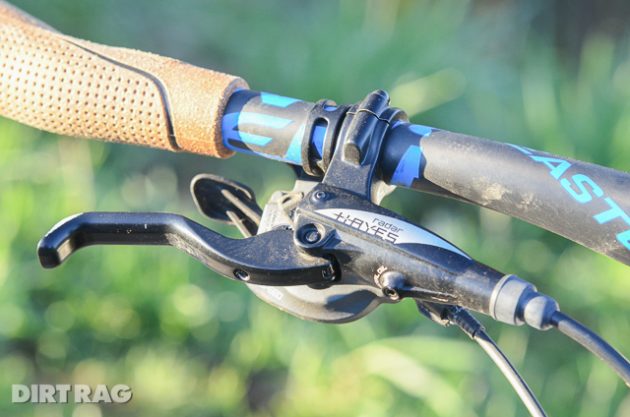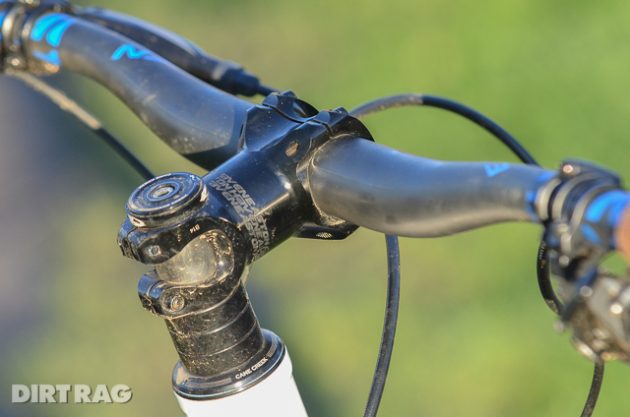Review: Advocate Cycles Hayduke
Originally posted on May 13, 2016 at 8:00 am
Tester: Adam Newman
Age: 35, Height: 6’2”, Weight: 180 lbs., Inseam: 34”
Price: $750 (frame). Complete bikes from $2,699
Sizes: S, M, L (tested), XL
More info: Advocate Cycles
The Hayduke is named for the infamous anti-hero of “The Monkey Wrench Gang,” Edward Abbey’s 1975 cult classic novel of radical environmentalism (and sabotage) in the wild American West. George Hayduke was a master of crippling the heavy equipment that built roads and dams on land he considered sacred, but he had no qualms about tossing an endless stream of empty beer cans out the window of his dusty Jeep.
Like George, the bike from the new brand Advocate Cycles has something of a split personality itself, in that customers can configure it with 29 inch wheels or 27plus. Thanks to its replaceable dropout design, it can also fit standard 142 mm thru-axle hubs or 148 mm Boost hubs. There’s even a singlespeed option with either hub spacing. Each is an entirely separate design, however, so the geared dropouts can’t be called into singlespeed mode the way some rocker or sliding dropouts can.
The steel frame is fairly straightforward in its construction, with Reynolds 725 tubing joining a 44 mm headtube, a BB92 bottom bracket shell and internal dropper post routing. One downside to the Hayduke is its weight— a full 7 pounds for the size large frame we tested. As pictured it spun the scale past the 32 pound mark.

The Hayduke has no trouble holding its own against other trail hardtails on the market these days. While I would normally go straight for an XL, I was actually glad I ended up on a large. The reach is still plenty long enough to keep the front wheel far out front, where I like it, while the slightly smaller stature helped it feel more responsive than it might have with a longer wheelbase. Because my saddle was also extended higher, and thus farther back, it also moved my weight slightly rearward, and helped make lifting the front end effortless. The 16.9 inch chainstays didn’t hurt either.
Just like Hayduke’s Jeep, this bike can tackle a little bit of everything— trail or no trail—and help you escape over the next mountain pass. It works well for a mix of uses beyond traditional mountain biking, veering into bikepacking and light-duty fat biking on sand or snow.

The extra weight will always be a drawback for 27plus compared to a standard 29-inch platform, and almost all of that weight is rotating mass in the wheels and tires. I think it does hold the Hayduke back if your goal is to go top speed all the time, but the versatility earned by those big tires more than makes up for it. The fore-aft traction is downright remarkable, and despite the weight I found it to be very capable on low-speed, techy climbs. The plus platform floats over holes that would typically catch your tire and kill your momentum or buck your behind off the saddle. The added surface area on the ground improves braking, but it’s not true that the big tires act as a suspension— this is still a hardtail through and through.
The truly unique thing about the brand, and thus its name, is that Advocate Cycles has pledged to donate 100 percent of its profits back to bicycle advocacy. Incorporated in Minnesota as a Specific Benefit Corporation, it has a legally binding social purpose in addition to its business ventures, and customers can give input on which of the organizations they would like to support. So far Advocate Cycles has partnered with IMBA, PeopleForBikes, the Adventure Cycling Association, Bicycles for Humanity and NICA.
Advocate Cycles are available through your local bike shop, but if you can’t find one in your area, give them a call and they will get you set up.
The build you see here isn’t a stock setup, but rather a mix of new and existing components as part of our Project 27plus test. Read our introduction to the bike here.

Wheels
Thanks to its own in-house design and manufacturing in North Carolina, Industry Nine was one of the first brands out of the gate with Boost compatible hubs. Its Torch Classic hubs use traditional J-bend spokes and spin on a six-pawl driver with 120 points of engagement. Do a little math and you’ll see that’s a nearly instantaneous three degrees of engagement.
The hubs are laced to WTB’s Scraper rims, the first “plus” rim designed for a 2.8 to 3 inch tire, with all the advantages of the TCS tubeless system. It’s a double-wall rim with a massive 45 mm internal width to help spread the plus tires out wide. For this project I’ve been running the WTB Bridgers.

Brakes
Hayes started with a clean-slate design for the Radar brakes, moving away from DOT fluid to a more user-friendly mineral oil fluid it calls Venom. They have a long lever arm that has plenty of room for two-finger braking, but can also be adjusted fore and aft for perfect single-finger fit.
If you’re a Brit or just prefer moto style, you can easily flip them upside-down and run them backwards. At the other end of the line, the calipers use Hayes’ Crosshair design that lets you micro-adjust their placement on the post mounts for drag-free operation.
Built for an entry-to-mid-level market, they have linear braking power but lack the sheer stopping force of some of the competition. Aside from a little squeal in the wet they performed great throughout the test, and sometimes reliability is more important than outright performance.

Cockpit
With such a big front wheel to wrangle I grabbed a pair of Easton’s Haven carbon handlebars with a 35 mm clamp and a manageable 750 mm width. Combined with the big tires the carbon bars absorbed any sort of hard knock or buzz traveling to my hands. With nine degrees of sweep and a modest 20 mm rise they felt great right away.
At the ends are the Primergo Jet ergonomic cork grips from Herrman’s. Though they are designed for city bike users, I found their modest size to be comfortable without being hard to handle when I’m constantly adjusting my position. They have a single locking bolt and offer plenty of grip in the wet.
Suspension
Up front is the new Manitou Magnum, designed specifically for “plus” bikes; it’s available in both 27plus and 29plus versions, and this is the Pro version with adjustable high and low speed compression as well as rebound and bottom-out. Watch for an in-depth review in an upcoming issue.
Details
- Reach: 18.0”
- Stack: 24.7”
- Top Tube: 24.8”
- Head Tube: 68.5º
- Seat Tube: 73º
- BB height: 12.4”
- Chainstays: 16.9”
- Wheelbase: 44.9”
- Weight: 32.2 lbs. w/o pedals (specs based on size tested)